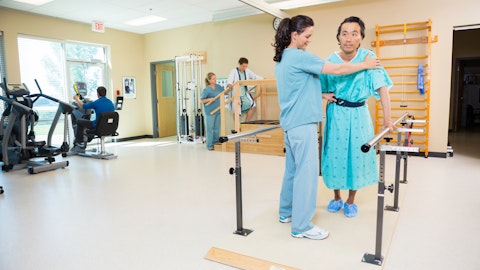Operator: The next question is from Caitlin Cronin with Canaccord Genuity.
Caitlin Cronin : Congrats on a great quarter. Just starting with 2024 revenue guidance, the 7% core business growth really kind of implies a slight slowdown year-over-year. What are really the expectations that are built into this?
Matt Trerotola: Yes. I think I wouldn’t really look at it as a slowdown in terms of our performance versus the market. I think it’s sort of broadly accepted that the recon market had at least 1 point or 2, maybe 2 or 3 points, of tailwind on it last year. And then we also, on the P&R side, had some extra price that we know it’s going to start to moderate. And so the 7% guide is pretty similar relative growth performance versus the markets, but also it’s consistent with our approach of trying to be a little conservative in terms of how we’re creating our plans and how we’re guiding as we come out of the year, until we see how the market is going to unfold a little bit in the early parts of the year.
Caitlin Cronin : Got it. And then you said earlier, similar cadence sequentially throughout the year versus last year, but Q1 was particularly strong in 2023. Do you kind of expect that similar strength in Q1 this year?
Ben Berry: Yes, Caitlin, I think in terms of my comments there, as I think about kind of the percentage of the year, in terms of what Q1 was of the full year in terms of revenue and EBITDA. That’s kind of what the comments I was trying to convey in my commentary, is we think kind of what we’ve seen in 2022 and 2023 is kind of a new normal kind of seasonality that we’ll see. So if you kind of do the math and look at how 2023 played out and look at kind of the percentage of each of those quarters, that’s kind of how we’re thinking about providing the guidance of quarterly movement.
Caitlin Cronin : Got it. That makes sense. And then just one more quick one. The $40 million of cost synergies for Lima by year 3, what does that really look like in years 1 and 2, and where you really see most of the effect down the P&L?
Ben Berry: Yes. I’ll start with kind of the first year. So again, as we contemplated our guidance for what we had said when we closed the — we announced the deal, of the $70 million to $75 million of EBITDA, that would include some of the near-term synergy that we’re able to capitalize on. And what you think about kind of there in terms of cost synergy opportunity is areas where there’s duplicative nature or overlap. So again, when my — AAOS is a good example, we both don’t need to pay for a booth now that we’re one company. There is some overlap in terms of leadership position that we’re able to make quick decisions on. So we’re able to capitalize on some kind of synergies early on here in the program. And so that would be kind of, I’d say, in that $5 million to $10 million range for year 1, and then building up to the $40 million kind of by year 3.
Operator: The next question is from Danielle Antalffy with UBS.
Danielle Antalffy : Congrats on a good end to the year. Just one quick question on the competitive landscape this morning. You did have a competitor announced the approval — 510(k) approval for their robotic solution for shoulder. I’m just curious what’s baked into your guidance as far as potential competition ramping — heating up here on the robotics side? And if you could remind us where you guys are with [indiscernible] solution? And then just one quick follow-up on Lima after that.
Matt Trerotola: Yes, sure. I mean, first, I’ll say, our guidance contemplates the full competitive environment that we’re in right now. In Shoulder, we’re a leader in Shoulder, we’ve been an innovation leader in Shoulder for many years. We’ve got the best shoulder implant in AltiVate with the longest data and also we’ve got continuing innovation that we’ve done around that. Enabling tech has been a significant force in shoulder for a while. We’ve had an industry-leading mass point solution for creating preoperative plans being able to then feed them into the surgery, being able to do patient-specific instrumentation to be able to find the glenoid volt in difficult cases. And so we have also been a leader in enabling tech in Shoulder for many years.
And that ability to kind of do presurgical planning and use patient-specific instruments is something that’s been around for a while in shoulder and is well used and part of what’s enabled us to continue to succeed. We definitely see opportunities over time for additional enabling tech in Shoulder. We’ve made significant investments as a company in augmented reality as well as predictive analytics. And we can see opportunities to take what is already quite valuable to shoulder surgeons in terms of the preoperative planning and some of the patient specific instrumentations. Simplify the workflow of that with augmented reality guidance and predictive analytics and create the next step change in terms of workflow in the shoulder, and do it in a cost-effective and space-efficient way that I think there’s quite a bit of excitement about over on the knee side as we’re bringing Arvis into that.
So we’re confident that, as the year plays out, we will remain a technology leader in Shoulder and that we’ll have the right offering at the right time. to move that next step in the Shoulder.
Danielle Antalffy : Okay. Great. And then on Lima, I know your guidance for Lima sales includes some exits of product lines, et cetera. Have you guys confirmed where you’re exiting yet? Or how should we think about that transpiring over the year?
Matt Trerotola: Yes. So that’s something that will play out through the year. There are a few things that we’ve just — kind of small amounts of revenue that we’ve stepped away from because they were not as attractive pieces of the revenue. But most of the revenue impact that we’ve factored in for this year is related to working by country by country and putting the channels together and, in some cases, having to make choices as we do that, that can relate to — result in some revenue going away from that, and — from us. And definitely, some of that will start to hit in the first quarter, but really not seeing much. And then in the next few quarters, we’d likely be seeing the rest of whatever impact we’re going to have in the year.
We’re working very hard to minimize that and we’re working very hard to try to find more synergies. Certainly, each time that we have a little bit of breakage is an opportunity to have synergy on the flip side of that, typically. And so there’s a little bit of a question of how the timing plays out and whether — how quickly can we cover breakage with synergy. But that’s something that we feel very confident with what we’ve put into our guidance in terms of what the Lima revenue will be. And we’re off to a good, strong start so far, and we’ll keep you posted as we work through the year.
Ben Berry: Yes. Danielle, I would just pile on, on that and say that as we think about kind of how Lima strengthens the overall portfolio and the registration environment around the world, there’s not going to be any kind of major product line discontinuation. We’re going to make the full portfolio available to our customers. And then over time, we’re going to continue to refine that and strengthen it as we drive new innovation, as we get registrations cleared in certain countries, and things like that. So I wouldn’t expect any kind of major kind of gaps or discontinuations in product line in the near term. There are some kind of choiceful things, as Matt said, that we’ll be doing kind of in the near term. But overall, I think this only strengthens our portfolio in terms of our ability to serve customers.
Operator: The next question is from George Sellers with Stephens Inc.
George Sellers : Maybe just switch to the P&R segment. You mentioned a few new launches there. Could you just parse out that low to mid-single-digit growth? What’s assumed from the new launches, maybe what’s assumed from pricing? And then just from an underlying market growth perspective, what is all baked in?
Matt Trerotola: Yes. I mean, so first, I’d say I think that looking at last year, it was a pretty normal P&R market overall and with maybe a tiny bit of tailwind in the market, but not as significant as on the Recon side, but a healthier price environment in terms of recovering some of the inflationary pressure from the previous years. And so when you look at our growth that was pushing 5% on the full year basis, that’s a little bit elevated from what we envisioned being able to do on a go-forward basis in that business. We’ve got 1% or so of price that we expect to more flatten out and probably a little bit of tailwind there was in the market last year. And so we still have a P&R long-term view in the sort of 3% to 4% range, which would reflect — kind of get into a more normal price environment.
And then as the innovation that we’ve been talking about continues to ramp its way through the business, that’s how we can kind of push towards that 4% realm that we’ve been showing consistently over the past few years, but with a little extra price into it. We also continue to work on shaping that business to be, let’s say, more of a solid mid-single-digit grower versus a low to mid-single-digit grower. And we see opportunities for that, and we’ve been working on them step by step. And so we’re still guiding it in the 3% to 4% range. We’re still working on making it something that we can guide in the 4% to 5% range.
George Sellers : Okay. That’s helpful. And then maybe on margins. You talked about a little bit about price and then also with the new product launches. How should we think about flow through to margins? I think some of the EXG initiatives, as you’ve been developing some of these, are maybe driving some more attractive margin profiles with these new devices. But just curious, for this segment specifically, how should we think about margins progressing through this year and beyond?
Ben Berry: Yes. So again, George, I think from a PR perspective, I think that’s your question, what Matt said is we continue to look at how do we drive shaping moves within that portfolio, which would focus on higher-margin products. So it would be around continuing to try to drive some improvements in the mix of the business within P&R, driving some leverage on the growth that we’re getting, the consistent growth that we’re getting as we’re continuing to just kind of drive good behavior and productivity within the supply chain there. So overall, I think that the contribution of mixing the portfolio shaping moves and then just operating leverage plus productivity is what we would see kind of helping drive incremental increases in the margins of that business over time. And as we kind of think about that business, we see it to consistently increase margins year-over-year.
Operator: The next question is from Mike Matson with Needham.
Q – Unidentified Analyst: This is Joseph on for Mike. I will start with a question on Arvis. Could you maybe remind us all how you guys expect to sell the product? I guess, will this be a direct source of revenue? Will you use it to drive implant sales indirectly or some combination of both?
Matt Trerotola: Yes, sure. So far, we are primarily placing Arvis as CapEx. It has a relatively low cost. And so in most of the places we put Arvis, we’ve placed it there, we’re getting a recurring revenue stream on that on a per procedure basis, which we’ve been able to get on contracts at rates consistent with some of the other enabling tech devices out there. And in some cases, where we placed it, it’s one of our existing surgeons, and it’s a way to strengthen and deepen our relationship with them. And in other cases, we’ve been able to convert surgeons and get new implant sales with it. So we’re tracking both the way that we ramp the recurring revenue there with placements, the way that we ramp the recurring revenue there, but then also the pull-through revenue on implants where we bring it into competitive environments.
And we expect it to contribute in all those ways. We have also been able to very successfully sell it as capital, and we’ll make thoughtful decisions about when it’s better to sell it versus place it. But one of the real advantages that we have with Arvis is that it is a primarily software based solution. And so there is not a very large cost related to placing it or selling it. And that gives us a lot of business model flexibility. And I think in a health care environment where there’s a lot of pressure on the system around health care economics, I think that over the next couple of years you’re going to see a lot of excitement, as was mentioned earlier in the call, around augmented reality, even mixed reality, as a way to really bring some of the real marketing benefits as well as the procedural benefits of enabling tech in knee and then other anatomies, while at the same time being much more cost base and time efficient.
Q – Unidentified Analyst: Okay. Yes. And then maybe just one on Lima. In the quarter, could you maybe give us some color or tell us what the Lima’s gross margin or operating margins were in the quarter? And just given that the ongoing integration of Lima, could you maybe talk about your outlook for M&A? Can we assume that some deals may be on hold as you guys continue to integrate the Lima?
Matt Trerotola: Yes. So let me comment. First of all, Lima is coming into our financial picture exactly as we expected it to. They had a good, healthy finish to the year in terms of their growth as well as their margin profile. And as we’ve created our plan for 2024, we’ve been able to take our base plan that we’re already working on and then put a Lima — put on top of that the Lima revenue and profit and margin impact, right in line with what we had expected in the acquisition process. And we have good, strong confidence in that from everything that we’ve learned and from everything that we’ve got in flight. So feeling very good about the start on Lima and the growth in margin picture that’s going to emerge from that as we execute through it.
As far as acquisitions, look, there’s no question that we’ve got a significant amount of work to do this year, making sure that Lima is a tremendous success. And we’ve even still been coming up the curve of taking full advantage of all the great Foot & Ankle acquisitions that we made, and even the laser acquisition we made 3 or 4 years back now, we’re still kind of ramping up further and further in terms of where we take that product line. So we’ve got a lot that we’re doing in terms of taking advantage of the things that we’ve acquired over the past handful of years. At the same time, we got a little bit of space financially for attractive strategic bolt-on acquisitions. Certainly, it’s a healthy environment out there for bolt-on acquisitions.
So we’ve got a healthy funnel of opportunities, but we’ll be very judicious here in 2024 about the acquisitions that we do. And we’ll focus really only on the most strategic and on ones that have — that are more in that kind of bolt-on range in terms of their — how they affect our balance sheet picture and how they affect our execution bandwidth. At the same time, we can continue to do the work on medium or larger things that we could think about in ’25 and beyond once we get through a fantastic integration of Lima and as we start to delever and have more space on the balance sheet.
Q – Unidentified Analyst: Great. Congrats on the quarter.
Operator: The next question is from Dane Reinhardt with Baird.
Dane Reinhardt : Maybe just 2 kind of follow-ups at this point in the call. The first one, though, kind of on the revenue guidance. If we just take out Lima, can you just kind of help us level set kind of what other what other factors you’re kind of expecting in there as it relates to FX? I think you still have some contributions from NovaStep and SEAL in there. And then it looks like you also pointed out some selling day impacts in the slide deck. So just help us kind of frame all those things together.
Ben Berry: Yes, Dane, thanks. So again, the guidance range that we’ve put together contemplates the factors that you mentioned, which again, I think from an underlying core business growth, we’re kind of seeing around 7%. Right now, if you look at kind of where currencies are, we would say that’s kind of relatively flat in terms of the impact outlook for the year. You’ve got kind of within the guidance there, the full contribution of both NovaStep and Lima as well. So overall, kind of feel like all the components are there and kind of fit within the guidance that we gave.
Dane Reinhardt : Okay. Sounds good. And then the second one, just kind of a follow-up on Vijay’s point with the Hip & Knee growth, I think 11% this quarter, relative to 18% last quarter. And I think your prior year comp from last year actually eased a little bit. So I mean, just anything else that we can kind of point to regarding that comp-adjusted slowdown even either from a competitive standpoint or potentially end markets?



